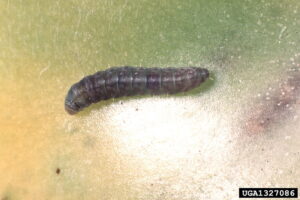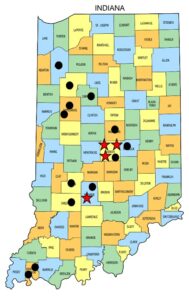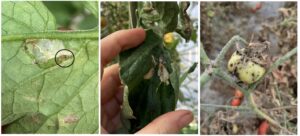Background
Tomato pinworm “TPW” (Keiferia lycopersicella) is a small microlepidopteran pest of solanaceous crops with a strong preference for tomato (Figure 1). It naturally occurs in warm climates of the U.S., including Texas, Florida, Hawaii, and California. It cannot survive outdoors in temperate climates, such as Indiana, where winter temperatures exceed a low threshold of 50° F that prohibits survival. However, an increasing number of greenhouse producers across all climates are reporting this pest each year, suggesting that warmer temperatures and a constant food source present in greenhouses may support TPW year-round.

Figure 1. Image of TPW caterpillar. Note that caterpillars can range in color from yellow, green (early stages) to purple (later stages) (Photo by Alton Sparks).
In addition to greenhouses, high tunnel tomato growers are also reporting TPW. A survey conducted across 17 high tunnel tomato sites in Indiana during August 2023 found TPW in 4 of them (Figure 2). It is currently unclear if buffered winter temperatures and year-round production under high tunnels will allow TPW to overwinter at these sites or if they were introduced (e.g., on transplants). Regardless of how they were introduced, TPW can be a devastating pest on tomatoes and will likely require management intervention if detected. In the past, this pest has been rare in Indiana, but we expect its range to spread in response to milder winters and the growing popularity of protected culture for tomato production.

Figure 2. Map of Indiana showing 17 high tunnel tomato farms that were scouted in Aug 2023 for tomato pinworm (TPW). Red stars indicate where TPW was detected and black dots where they were not.
Identifying tomato pinworm damage
Early instars of TPW caterpillars are light-colored (yellow to green) and will feed in leaf mines. Unlike leafminers, TPW mines are not narrow and meandering. TPW mines are blotchy and present in folded leaves (Fig. 3). Older instars may remain within the leaves or exit to infest the fruit before they drop to the ground to pupate (Figure 3). Mines into the fruit are typically near the stem and will be indicated by a pinhole; small round entrances surrounded by dark frass or excrement from the caterpillar inside the fruit.

Figure 3. Examples of damage by TPW (left) as a young instar caterpillar within a leaf mine, by an older instar within a curled leaf (center), and by caterpillars boring into the fruit (right). Note the pinhole entrances into the fruit are surrounded by dark frass (caterpillar droppings) (Photos by Samantha Willden and participating growers).
Management
Because the source of TPW on high tunnel tomato is currently unclear, it is imperative that growers scout all transplants for signs of TPW (eggs, caterpillars, and leaf mines) before they are planted. Remove and destroy any infested plants and plant parts. This step will greatly reduce the risk of TPW infestation.
Scouting for adults can occur by deploying pheromone-baited traps at planting and checking them weekly for small, drab moths (Figure 4). However, correct identification of pinworm adults can be difficult, and therefore, we recommend sending specimens to the Purdue Plant and Pest Diagnostic Laboratory.

Figure 4. Summer research technician Bela Arias checking a pheromone-baited monitoring trap for tomato pinworm (Photo by Samantha Willden).
Because TPW can cause direct damage to tomatoes, the management threshold for this pest is very low. Mating disruption can be an effective option for early management of TPW in isolated tomato fields, but all tomatoes within the area must be treated. This approach will reduce successful mating and egg laying on the tomato crop but can be costly. If damage is already present, insecticides can be effective against the younger caterpillars. Refer to the Midwest Vegetable Production Guide for more information on insecticides for TPW. Be sure to follow label instructions for application, and it is recommended to follow greenhouse rates, re-entry intervals (REI), and post-harvest intervals (PHI) for high tunnels.
Sanitation is currently the best tool against TPW. Removing infested plant parts and fruit will reduce TPW presence within and between growing seasons. If TPW is present in one year, a host-free period of at least 3 months or more is recommended to break the TPW generational cycle. Consider cover cropping or rotating a non-solanaceous crop into the high tunnel. Remove any solanaceous weeds within and near the high tunnel, as they could be alternative hosts for TPW.
This article is an update from “Lookout for Tomato Pinworm: A Rare but Very Hungry Caterpillar that Can Devastate Tomatoes” by Elizabeth Long.